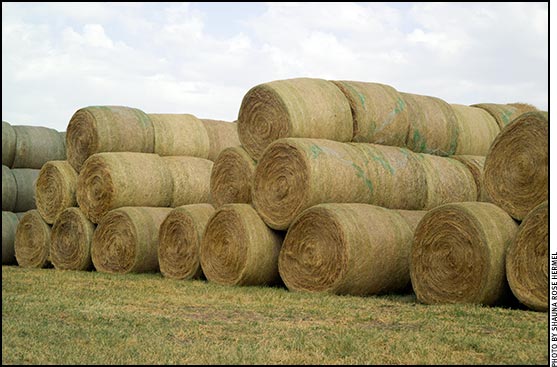HEALTH & NUTRITION...

Critical 60 Days
Hay quality fed to heifer affects calving success for next two years.
The quality of hay fed to a beef heifer the next 60 days of winter will determine the vigor of her calf to be born next spring and whether she can rebreed to calve the next year.
The amount of fat on a heifer’s back determines the care she needs, says Justin Sexten, University of Missouri (MU) Extension beef nutritionist. His concern includes condition of cows in a herd, but heifers pregnant with first calves need extra nutrition.
Sexten is concerned about the coming calf crop — for the next two years — because of drought last summer. Too many beef females are going into winter without protective layers of fat that help carry them through until spring grass. Read more.
Cold Weather Increases Livestock Energy Needs
While colder temperatures now experienced throughout the region mean livestock producers need to be aware of increased livestock energy requirements, those animals that may be thinner because of the drought could need extra energy supplements sooner, an Ohio State University (OSU) Extension educator said.
Cold temperatures, cold rains and muddy conditions can significantly increase the energy required by livestock metabolism to provide enough heat for the animal to maintain its body temperature, said Rory Lewandowski, an agricultural and natural resources educator for OSU Extension.
Those animals that have less body condition and less body fat as a result of grazing on drought-impacted pastures may need to have that additional supplement sooner to be able to produce the energy needed to weather the cold period, he said. Read more.
New Vaccine for Foot-and-mouth Disease
A newly created vaccine against foot-and-mouth disease (FMD) is the first of its kind to be licensed by the USDA Center for Veterinary Biologics. The novel approach taken to create this vaccine makes possible its manufacture in the United States. The vaccine was originally developed by Marvin Grubman of the Agricultural Research Service (ARS) at Plum Island Animal Disease Center and took seven years to develop and license with scientists at GenVec Inc. GenVec has licensed the rights to develop and commercialize this vaccine technology to Merial, the animal health division of Sanofi. Read more.
Tick Tock
Properly time vaccinations for reproductive success.
Timing is everything when it comes to successful reproductive programs, and that includes timing of vaccinations to help prevent reproductive diseases. Following the timing guidelines on product labels is critically important to helping guarantee safety and efficacy.
“Vaccinating against reproductive diseases helps keep cows pregnant, helping protect your reproductive program and bottom line,” says Victor Cortese, director of the Veterinary Specialties Group at Pfizer Animal Health. “However, working with your veterinarian to set up vaccination programs and following labeled directions are key to vaccine efficacy and safety, especially when using modified-live virus (MLV) vaccines.” Read more.

Rick Rasby
Ridin’ Herd
Developing replacements: feed challenges.
The drought of 2012 has posed challenges for cow-calf producers to source feed and forages for the winter. Even in these tough times, cow-calf producers have kept enough heifers to replace some of the cows that have left the herd. A challenge with this group of females is to design a nutrition program for them to reach their target weight before the start of the breeding season using some medium- to low-quality forages.
Corn residues are a relatively inexpensive feed resource, but they are low in protein and energy, especially for growing calves and replacement heifers. Beef producers often target a specific average daily gain (ADG), so it is important to know the amount of a supplement to feed to calves grazing corn residues in order to achieve a desired level of gain. Read more.
Ringworm in Young Cattle
This fungal skin disease often appears in weaned calves and yearlings during winter, but generally disappears without treatment by spring. Young animals are most susceptible because they have no immunity.
“Ringworm can spread from species to species, including humans,” says Matt Miesner, clinical assistant professor in the Kansas State University College of Veterinary Medicine. When handling cattle with ringworm, avoid contact with these skin lesions. Read more.
Water from the Sun
Solar-powered well pumps help Georgia farmers protect cattle, water quality.
University of Georgia–Athens (UGA) researchers are hoping solar-powered wells will help preserve water quality and cattle health on isolated Georgia cattle farms.
The system uses solar panels to power an electric well pump that provides water for cattle on isolated pastures. It has been used for the past year in Madison County where a farmer found that less than five hours of sunlight per day was enough to keep water tanks full. Read more.
Cattle Diseases: Common Conditions/Terms
Click here for a list of common conditions and terms related to beef cattle diseases, such as anaplasmosis, brucellosis, BVD, E. coli, IBR and others.
[Click here to go to the top of the page.]











